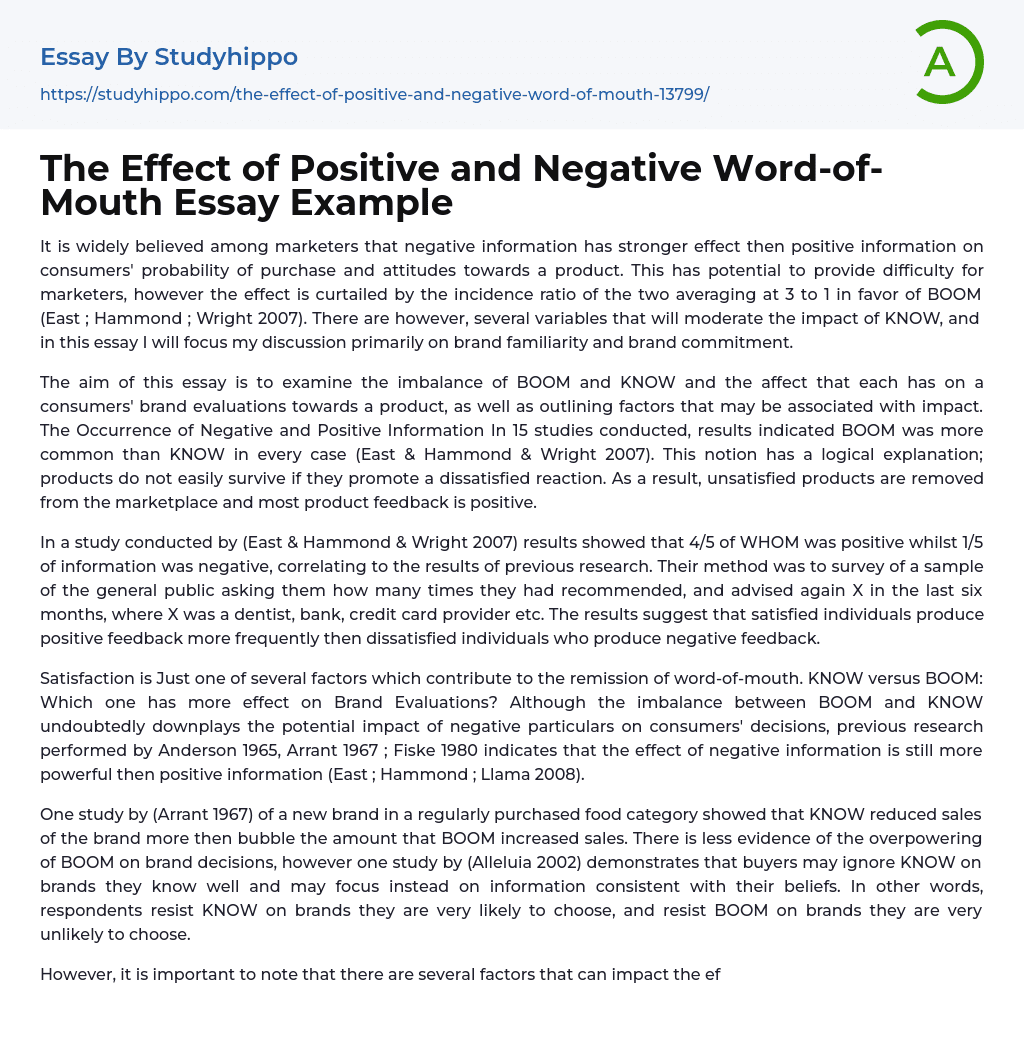

The Effect of Positive and Negative Word-of-Mouth Essay Example
It is widely believed among marketers that negative information has stronger effect then positive information on consumers' probability of purchase and attitudes towards a product. This has potential to provide difficulty for marketers, however the effect is curtailed by the incidence ratio of the two averaging at 3 to 1 in favor of BOOM (East ; Hammond ; Wright 2007). There are however, several variables that will moderate the impact of KNOW, and in this essay I will focus my discussion primarily on brand familiarity and brand commitment.
The aim of this essay is to examine the imbalance of BOOM and KNOW and the affect that each has on a consumers' brand evaluations towards a product, as well as outlining factors that may be associated with impact. The Occurrence of Negative and Positive Information In 15 studies condu
...cted, results indicated BOOM was more common than KNOW in every case (East & Hammond & Wright 2007). This notion has a logical explanation; products do not easily survive if they promote a dissatisfied reaction. As a result, unsatisfied products are removed from the marketplace and most product feedback is positive.
In a study conducted by (East & Hammond & Wright 2007) results showed that 4/5 of WHOM was positive whilst 1/5 of information was negative, correlating to the results of previous research. Their method was to survey of a sample of the general public asking them how many times they had recommended, and advised again X in the last six months, where X was a dentist, bank, credit card provider etc. The results suggest that satisfied individuals produce positive feedback more frequently then dissatisfied individuals wh
produce negative feedback.
Satisfaction is Just one of several factors which contribute to the remission of word-of-mouth. KNOW versus BOOM: Which one has more effect on Brand Evaluations? Although the imbalance between BOOM and KNOW undoubtedly downplays the potential impact of negative particulars on consumers' decisions, previous research performed by Anderson 1965, Arrant 1967 ; Fiske 1980 indicates that the effect of negative information is still more powerful then positive information (East ; Hammond ; Llama 2008).
One study by (Arrant 1967) of a new brand in a regularly purchased food category showed that KNOW reduced sales of the brand more then bubble the amount that BOOM increased sales. There is less evidence of the overpowering of BOOM on brand decisions, however one study by (Alleluia 2002) demonstrates that buyers may ignore KNOW on brands they know well and may focus instead on information consistent with their beliefs. In other words, respondents resist KNOW on brands they are very likely to choose, and resist BOOM on brands they are very unlikely to choose.
However, it is important to note that there are several factors that can impact the effect of word-of-mouth transmissions. Factors that may be associated with impact Researchers have revealed the impact of WHOM on brand evaluations is moderated by brand familiarity. Brand familiarity reflects the brand-related experiences accumulated by a buyer, such as advertisements and recognition and a brand name. In her work, (Alleluia 2002) compared written responses to positive and negative information on a brand to which consumers were either familiar or unfamiliar with.
Consumers familiar to the brand appeared to accept positive information but oppose negative information with counter- arguments.
Her findings demonstrate that KNOW has more effect on consumers with owe familiarity to a particular brand, in comparison with highly familiarized consumers. In earlier work, (Alleluia ; Burbank ; Naval 2000) conducted a study that involved exposing consumers who had prior brand commitment to Nikkei to negative information in the form of newspaper articles.
In this study brand commitment was defined as "a form of attitude strength" and measured using support arguments, counter-arguments and attitude. Her results found that negative information had far more effect on consumers with low commitment to the brand. Another variable that is likely to moderate the processing of WHOM messages n 'brand name', which is considered a significant factor in influencing consumers' perceptions. Other factors may include room for change, demographics, personal preference and the relationship between the sender and the receiver.
Conclusion Overall, it has been demonstrated by researchers that BOOM is more common then KNOW in a marketing environment. Both communications are believed to be based primarily on satisfaction or dissatisfaction and exert opposing influences on consumer choice, although it is generally believed that KNOW has a stronger effect the BOOM on brand evaluations. The effect of negative information can however, be downplayed by various factors that are specific to the consumer to whom the endorsement is been made.
- Wal-Mart essays
- Discover essays
- Brand Equity essays
- Branding essays
- Nike, Inc. essays
- Market share essays
- Razor essays
- Chief Executive Officer essays
- Convenience Store essays
- Firm essays
- Training And Development essays
- Unilever essays
- Variable Cost essays
- Virgin Group essays
- Bargaining essays
- Entity essays
- Pest analysis essays
- Advertisement essays
- Advertising essays
- Anheuser-busch essays
- Audience Theory essays
- Brand essays
- Brands essays
- Competitor Analysis essays
- Consumer essays
- Detergent essays
- Marketing Management essays
- Marketing Mix essays
- Marketing Plan essays
- Marketing Research essays
- Marketing Strategy essays
- New Product Development essays
- Point Of Sale essays
- Price essays
- Procurement essays
- Product essays
- Product Differentiation essays
- Product Placement essays
- Promotion essays
- Promotion And Marketing Communications essays
- Research Design essays
- Retailing essays
- Trademark essays
- Board Of Directors essays
- Brand Management essays
- Business Ethics essays
- Business Management essays
- Change Management essays
- Comparative Analysis essays
- Decision Making essays



